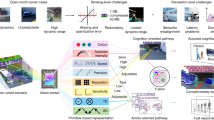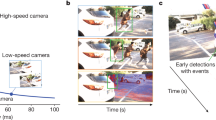Abstract
When the two eyes are confronted with sufficiently different versions of the visual environment, one or the other eye dominates perception in alternation. A similar situation may be created in the laboratory by presenting images to the left and right eyes which differ in orientation or colour. Although perception is dominated by one eye during rivalry, there are a number of instances in which visual processes nevertheless continue to integrate information from the suppressed eye1–6. For example the interocular transfer of the motion after-effect is undiminished when induced during binocular rivalry6. Thus motion information processing may occur in parallel with the rivalry process. Here we describe a novel example in which the visual system simultaneously exhibits binocular rivalry and vision that integrates signals from both eyes. This apparent contra-diction is resolved by postulating parallel visual processes devoted to the analyses of colour and motion information. Counterphased gratings are viewed dichoptically such that for one eye the grating is composed of alternating yellow and black stripes (luminance) while for the other it is composed of alternating red and green stripes (chrominance). When the gratings are fused, a moving grating is perceived. A consistent direction of motion can only be achieved if left and right monocular signals are integrated by the nervous system. Yet the apparent colour of the binocular percept alternates between red-green and yellow-black. These observations demonstrate the segregation of processing by the early motion system from that affording the perception of colour. Although, in this stimulus, colour information in itself can play no part in the cyclopean perception of motion direction, colour is carried along perceptually (filled in) by the moving pattern which is integrated from both eyes.
This is a preview of subscription content, access via your institution
Access options
Subscribe to this journal
Receive 51 print issues and online access
$199.00 per year
only $3.90 per issue
Buy this article
- Purchase on Springer Link
- Instant access to full article PDF
Prices may be subject to local taxes which are calculated during checkout
Similar content being viewed by others
Author information
Authors and Affiliations
Rights and permissions
About this article
Cite this article
Carney, T., Shadlen, M. & Switkes, E. Parallel processing of motion and colour information. Nature 328, 647–649 (1987). https://doi.org/10.1038/328647a0
Received:
Accepted:
Issue Date:
DOI: https://doi.org/10.1038/328647a0
This article is cited by
-
The temporal frequency tuning of continuous flash suppression reveals peak suppression at very low frequencies
Scientific Reports (2016)
-
Form and motion have independent access to consciousness
Nature Neuroscience (1999)
Comments
By submitting a comment you agree to abide by our Terms and Community Guidelines. If you find something abusive or that does not comply with our terms or guidelines please flag it as inappropriate.



